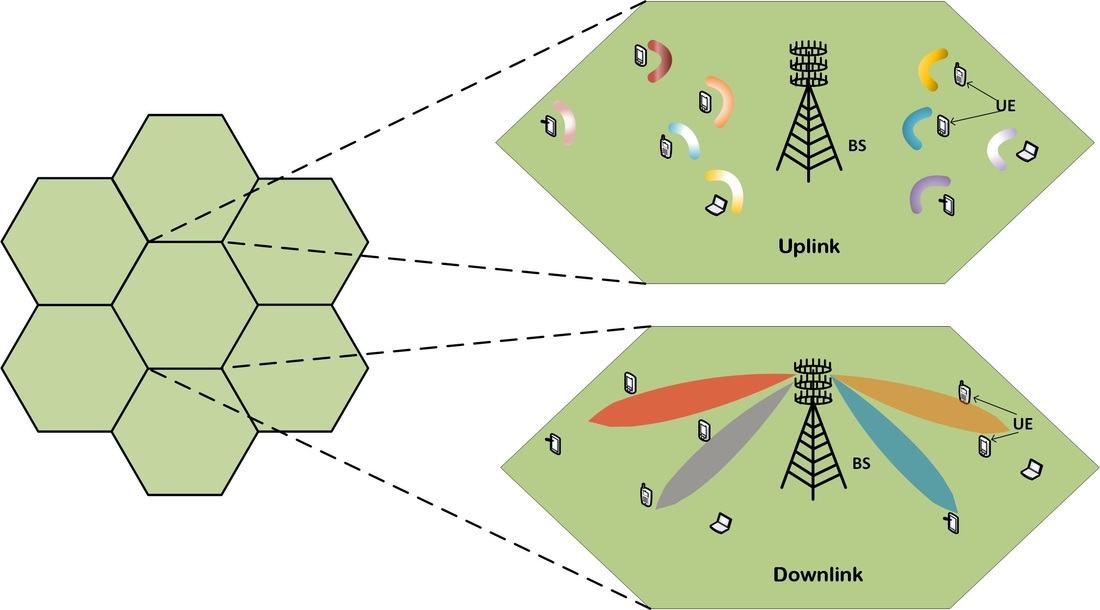Massive Multiple Input Multiple Output (MIMO)
Massive MIMO systems can signify antenna arrays comprising of a hundred, or a few hundreds, of antennas, simultaneously serving multitude of users. The main idea is that the physical size of each individual antenna can be very small, and be built from inexpensive hardware. Also the ratio of the number of antennas at the base station to the number of users being served is much greater than one. With a massive antenna array, things that were random before start to look deterministic (an application of the "Law of Large Numbers"). As a result, the effects of small-scale fading can be averaged out. Moreover, with the increase in the number of BS antennas, the random channel vectors between the users and the base station become pairwisely orthogonal. Uncorrelated noise and intracell interference can be removed completely with simple matched filtering techniques. Massive MIMO systems are also very power efficient. Reducing the transmit power of the terminals in the uplink will drain their batteries slower. On the other hand, in the downlink transmission, the electrical power consumed by a BS is spent mainly by power amplifiers and associated circuits and cooling systems. Hence, reducing the emitted RF power would help in reducing the power consumption of the BS considerably
Research
Members Involved : A. Papazafeiropoulos, Sudip Biswas
We analyze the performance of Massive MIMO systems with respect to more realistic scenarios. One of the constraints of using large dimensional arrays is the constrained physical space that is actually available to rig these antennas. One solution to deploy the antennas with a small space is to reduce the spacing between the antennas (possibly below half the wavelength of the transmitted frequency). This however gives rise to two effects, namely mutual coupling due to the close proximity of the circuit components of the antennas and antenna correlation due to the interfering signals among the antennas. Our analysis thus shows that EE does not increase infinitely in a massive MIMO system when the increasing number of antennas are to be accommodated within a fixed physical space and the total power consumed is considered to be a function of the antennas.
We also use stochastic geometry and large random matrix theory as tools to analyze the performance of such systems. Furthermore, we also explore on the non-ideal channels available for massive MIMO by taking into consideration delayed CSIT and time varying massive MIMO systems.
Publications
- S Biswas, J Xue; F Khan, T Ratnarajah, “Performance Analysis of Correlated Massive MIMO Systems with Spatially Distributed Users,” IEEE Systems Journal, Vol. 12, No. 2, pp. 1850-1861, June 2018.
- A. Papazafeiropoulos and T. Ratnarajah, "Rate-Splitting Robustness in Multi-Pair Massive MIMO Relay Systems,” IEEE Trans on Wireless Communications, Vol. 17, No. 8 pp. 5623-5636, Aug. 2018.
- A. Papazafeiropoulos, B. Clerckx, and T. Ratnarajah, "Rate-Splitting to Mitigate Residual Transceiver Hardware Impairments in Massive MIMO Systems," IEEE Trans on Vehicular Technology, Vol. 66, Issue 9, pp. 8196-8211, Sep. 2017.
- A. Papazafeiropoulos, H. Ngo and T. Ratnarajah, "Performance of Massive MIMO Uplink with Zero-Forcing receivers under Delayed Channels", IEEE Trans. on Vehicular Technology, Vol. 66, Issue 4, pp.3158-3169, April 2017.
- S Biswas, C Masouros, T Ratnarajah, "Performance Analysis of Large Multi-User MIMO Systems with Space-Constrained 2D Antenna Arrays,“ IEEE Transactions on Wireless Communications, Vol 15, No. 5, pp. 3492-3505, May 2016.
- A. Papazafeiropoulos and T. Ratnarajah, "Deterministic Equivalent Performance Analysis of Time-Varying Massive MIMO Systems," IEEE Trans. on Wireless Communications, Vol. 14, No. 10, pp. 5795-5809, Oct. 2015.
- C. Masouros, M. Sellathurai and T. Rantarajah, "Large-scale MIMO transmitters in fixed physical spaces: the effect of transmit correlation and mutual coupling," IEEE Trans. on Communications, Vol. 61, No. 7, pp. 2794-2804, July 2013.
- A. Papazafeiropoulos and T. Ratnarajah, "Impact of Rate-Splitting Robustness in Multi-Pair Massive MIMO Relay Systems," In Proc. IEEE Global Communications Conference, Singapore, 4-8 Dec. 2017.
- S Biswas, C Masouros, T Ratnarajah, “On the Energy Efficiency of Massive MIMO with Space-Constrained 2D Antenna Arrays,” in proc IEEE International Conference on Communications 2016.
- J. Xue, T. Ratnarajah, C. Zhong and Chao-Kai Wen, "Reliability Analysis for Large MIMO Systems," IEEE Wireless Communications Letters, Vol. 3, No. 6, pp. 553-556, Dec. 2014.
- S. Biswas, J. Xue, F. Khan and T. Ratnarajah, "On the Capacity of Correlated Massive MIMO Systems using Stochastic Geometry," In Proc. the IEEE International Symposium on Information Theory, June 14-19, 2015, Hong Kong.
- S. Biswas, C. Masouros, T. Ratnarajah, "On the effect of Antenna Correlation and Coupling on Energy-Efficiency of Massive MIMO Systems," In Proc. IEEE 25 Annual International Symposium on Personal, Indoor and Mobile Radio Communications, Washington D.C., USA, Sep. 02-5, 2014.
- A. Papazafeiropoulos, H. Q. Ngo, M. Matthaiou and T. Ratnarajah, "Uplink Performance of Conventional and Massive MIMO Cellular Systems with Delayed CSIT," In Proc. IEEE 25 Annual International Symposium on Personal, Indoor and Mobile Radio Communications, Washington D.C., USA, Sep. 02-5, 2014.
- A Papazafeiropoulos and T Ratnarajah, "Uplink Performance of Massive MIMO Subject to Delayed CSIT and Anticipated Channel Prediction," In Proc. the IEEE 39th International Conference on Acoustics, Speech and Signal Processing, Florence, Italy, May 4-9, 2014.
- A. Papazafeiropoulos and T. Ratnarajah, "Precoding for Downlink Massive MIMO with Delayed CSIT and Channel Prediction," In Proc. the IEEE Wireless Communications and Networking Conference, Istanbul, Turkey, April 6-9, 2014.

